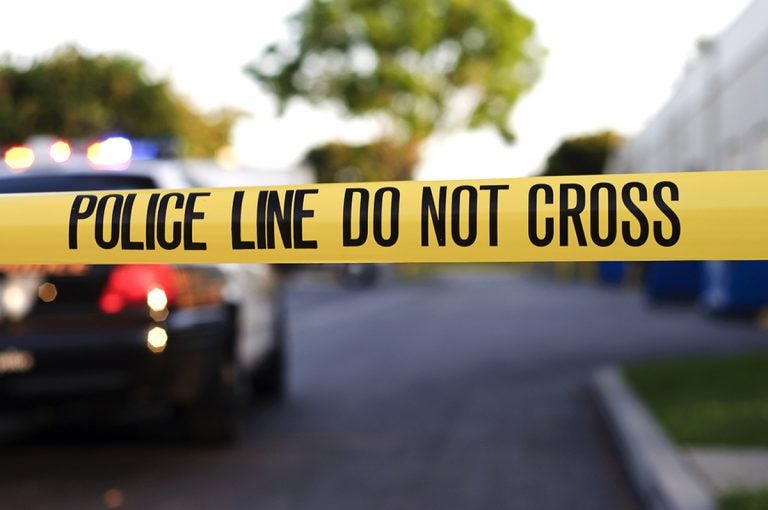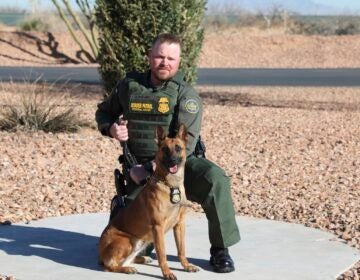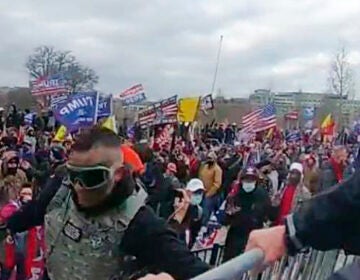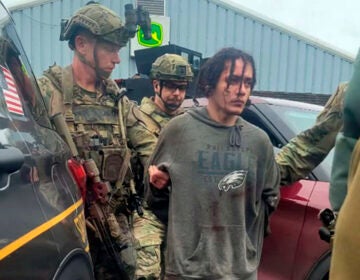Police shooting raises questions about use of force training
Recruits learn procedural justice, which involves using a measured tone of voice, careful choice of words and nonthreatening physical approach to avoid conflict.

(John Roman Images/Bigstock)
The woman in the park with the gun wouldn’t stop talking.
Hopping nervously from foot to foot, she ignored the police officer’s barked orders to drop the pistol and insisted, “No, it’s fine, it’s cool, it’s no big deal.”
Holding his gun steady, the officer shouted commands over the woman’s voice while keeping a close watch on her hands. The second she began to raise the one with the gun, he fired three shots into her midsection. She fell, lifeless, behind a shrub.
As her body lay frozen on the projector screen behind him, Richard Vona, a former Warwick, Bucks County, police sergeant who trains officers in the use of deadly force calmly discussed his decision to shoot the woman — an actress in an interactive training video.
The woman’s refusal to comply with his simple commands, combined with her body language, told Vona she was a danger to him and others. Once she began to raise the weapon, he felt he had to act quickly.
“There’s got to be a point in time where you make the decision to take the next step, otherwise you lose all ability to control the situation,” said Vona, director of Bucks County’s Public Safety Training Center.
The validity of the use of deadly force by a police officer was raised again last week after an incident near Dorney Park in South Whitehall Township. After asking for backup in dealing with a man with a “mental issue” who was jumping on moving cars on Hamilton Boulevard, a South Whitehall officer fired five shots at Joseph Santos, who ignored commands to “get on the ground.” Santos, 44, of Hasbrouck Heights, N.J., died on the spot.
The Supreme Court has long held that a police officer’s perspective at the time of a shooting carries the most weight when deciding whether a shooting was justified. But a string of police killings caught on video has some reform advocates saying it’s time to rethink police training to stress de-escalation in cases such as Santos’.
“Instead of giving them a command, you empathize with their emotion and then tell them why you need them to do something,” said Dennis Marsili, director of the Criminal Justice Training Center at Indiana University of Pennsylvania.
Many questions remain about the evening Santos was killed, including why he left a birthday celebration at Dorney Park and how he ended up on cars driving down Hamilton Boulevard — including the hood of the officer’s cruiser. At a vigil in Santos’ honor that drew about 100 people, many had a question for the officer: Why shoot an unarmed man? In the videos circulating on social media, Santos does not appear to be holding a weapon.
Under the law, that matters little.
The law says police officers must act “reasonably” when faced with a situation like the one that led to Santos’ death, but it takes into consideration the stressful nature of police work and the split-second decisions officers must make.
Each police department has its own policy on whether officers must carry nonlethal weapons such as Tasers. South Whitehall declined to release its policy and The Morning Call has filed a request for it under the Right to Know Law. There is no umbrella law requiring police officers to first use a Taser on a person who is not complying with demands.
That makes sense, Vona said, since every police officer is trained to prevent a suspect from overpowering them and grabbing their service weapon.
“People don’t understand what it’s like to be out there, fighting for your life,” Vona said. “If they lose control over their weapon, potentially that’s life-ending.”
Teaching recruits
Numerous police-involved shootings of unarmed black men across the country have been captured on cellphone videos in recent years, horrifying the public and putting pressure on police departments to review lethal force policies and training. Many states expanded the amount of time recruits spend on how to respond to mental health emergencies and talk down potentially violent subjects without using force.
According to a 2017 survey of police training curricula by the Council of State Governments Justice Center, all but two of 42 states that responded already had training in mental health issues and de-escalation. While 16 recently expanded the number of hours recruits spend on those topics, another 18 reported they planned to do so.
But half the states that responded said recruits are required to spend fewer than 20 hours of police academy training on mental health issues and de-escalation.
Pennsylvania’s newest police academy curriculum requires 23 weeks of training, of which 26 hours are devoted to behavior management and crisis intervention, recognizing people with special needs and responding to people with mental illness.
The Council of State Governments study does not identify which states increased their training requirements. A state police spokesman did not respond to a question about whether Pennsylvania has increased its mental health training requirement for police recruits.
The trend toward more mental health training recognizes that police are often the first to interact with people in crisis or under the influence of drugs.
“It’s a response to the fact that their resources are being stretched thin and being asked to fulfill missions they never intended to fill,” said Richard Cho, head of the law enforcement division for Council of State Governments.
He said it’s time to do more than train better. He said law enforcement must see crisis response as part of its core mission.
“Unless we bone up on our ability to respond to these kinds of incidents, we’re going to continue to see negative dispositions,” he said.
Pennsylvania recently revised its police training curriculum, adding more than four weeks to the program. Marsili, from Indiana University of Pennsylvania, said the additions focus on techniques to avoid conflict and build partnerships in the communities officers patrol. The goal, he said, is for police to act more as peace officers than occupiers.
Recruits learn procedural justice, which involves using a measured tone of voice, careful choice of words and nonthreatening physical approach to avoid conflict.
Police are taught to use requests and explanations rather than commands to persuade subjects to comply. An officer might explain that he needs a driver to step out of the car so that he can see the driver doesn’t have a weapon, rather than ordering him to do so.
Recruits are also taught to slow down encounters when there’s no immediate danger.
“A recruit may not know, ‘Should I step in or should I wait for backup.’ There’s no need to rush in if you don’t have to,” Marsili said. “It will be safer for you, safer for the community if you wait until you have backup, whatever the situation is.”
The emphasis on de-escalation represents a reset in police culture, Marsili said
“We have to, as law enforcement, be more in tune with our image and how we’re perceived in the community,” he said.
The vast majority of encounters police have with citizens are resolved without force, noted Maria Haberfeld, a professor of police science at John Jay College of Criminal Justice in New York. Those encounters go unnoticed. But when someone gets hurt and the exchange is recorded and disseminated, it creates a distorted perception. The level of violence used by police has not escalated, Haberfeld said.
Vona, who trains officers in Bucks County and teaches recruits at Temple University’s Municipal Police Academy, cringes when he sees people watching a video of a police-involved shooting and critiquing an officer’s actions. Questions like, “Why didn’t he just shoot him in the leg?” are particularly troublesome.
“The problem with that concept is that’s driven by popular media, by the Lone Ranger shooting the gun out of the bad guy’s hand,” he said. “That’s great TV but that’s not reality.”
Most officers are not proficient enough marksmen to target a small, moving target like a leg while under stress, Vona said. That’s why officers are trained to shoot into an attacker’s center mass, the chest and abdomen.
Though he never shot anyone during his 27 years as a police officer, Vona said the officers he’s talked to who have were deeply affected.
“There’s no high fives, there’s no joy in that,” Vona said. “It’s a traumatic incident.”
Test of a reasonable officer
The impetus for some of the new police training was the 1991 Rodney King assault, one the country’s most notorious cases of police use of force. A bystander filmed Los Angeles police officers beating King and gave the footage to a TV station. That thrust police misconduct into the national spotlight. Riots erupted across the city when the four officers were acquitted in 1992.
The King case gave birth to de-escalation training, said Haberfeld, who has worked with police around the world and is critical of American police training. She doubts that de-escalation techniques prevent the use of force.
“It all sounds very nice in the classroom, but on the street when they have a moment or two to decide and their life is on the line, all that de-escalation goes out the window,” she said.
That’s because police training begins with use-of-force options, laying out increasing levels of force that police officers may use, ranging from physical presence and verbal commands to striking with hands or knees, up to deadly force.
Haberfeld noted that while American police departments are among the most heavily armed in the world, they receive less training than police in a number of other countries, including Finland, where three years of college are required.
“You need to re-evaluate the entire training, not just the use-of-force training, to implement transformational change,” she said.
But with 18,000 police departments and 660 academies in the United States, there’s little standardization, which makes overhauling police training in a transformational way highly challenging.
WHYY is your source for fact-based, in-depth journalism and information. As a nonprofit organization, we rely on financial support from readers like you. Please give today.




